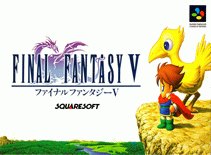
































Final Fantasy V

Final Fantasy V is a medieval-fantasy role-playing video game developed and published by Square in 1992 as a part of the Final Fantasy series. The game first appeared only in Japan on Nintendo's Super Famicom (known internationally as the Super Nintendo Entertainment System). It has been ported with minor differences to Sony's PlayStation and Nintendo's Game Boy Advance. An original video animation produced in 1994 called Final Fantasy: Legend of the Crystals serves as a sequel to the events depicted in the game. It was released for the PlayStation Network on April 6, 2011 in Japan. An enhanced port of the game, with new high-resolution graphics and a touch-based interface, was released for iPhone and iPad on March 28, 2013, and for Android on September 25, 2013.
The game begins as a wanderer named Bartz investigates a fallen meteor. There, he encounters several characters, one of whom reveals the danger facing the four Crystals that control the world's elements. These Crystals act as a seal on Exdeath, an evil sorcerer. Bartz and his party must keep the Crystals from being exploited by Exdeath's influence and prevent his resurgence.
Final Fantasy V has been praised for the freedom of customization that the player has over the characters, achieved through the greatly expanded Job System. Despite being released only in Japan, the Super Famicom version sold more than two million copies. The PlayStation version has earned 'Greatest Hits' status, selling more than 350,000 copies.
Final Fantasy V includes many standard role-playing elements as well as renovated features introduced in earlier Final Fantasy games. Players navigate from a top-down perspective; a traversable overworld connects the various towns, dungeons, and other points of interest. The player can traverse the overworld by foot, Chocobo, hydra-guided ship, wind drake, or airship, depending on the situation. Most towns contain scattered inns for resting, shops for purchasing equipment, and people from whom the player can gain information. The player may also embark on several side quests that become available as the story progresses. Characters grow in strength by gaining experience points from random encounters with monsters on the overworld or in a dungeon. Experience culminates in a 'level up', in which character attributes such as hit points and magic power increase. A menu-based management system allows the player to equip, heal, and change each character's selected job outside of battle as well as to save the game's progress.
Final Fantasy V is the second Final Fantasy game to use the Active Time Battle (ATB) system, in which time flows continuously for both the player and enemies during combat. This system was first established in Final Fantasy IV, but in that game, there was no way to visibly anticipate which character's turn would come up next. In Final Fantasy V, the player can see which playable character's turn is next in battle, in the form of a time gauge—or 'ATB Bar'—which fills according to a character's speed. When the selected character's turn arrives, the player can execute one of several commands, such as attacking the enemy with an equipped weapon, using a special ability or item, or changing the character's row position. The ATB mechanic with a gauge, as seen in Final Fantasy V, would be used in the four following main titles in the series and remains a staple mechanic of the franchise.
How to play:
Click on the joystick icon in the Final Fantasy V online emulator to see how to control the Final Fantasy V game









































Comments